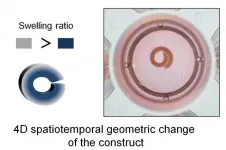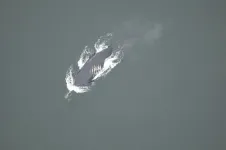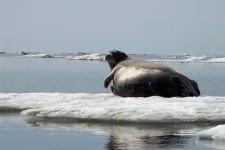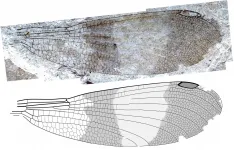(Press-News.org) New hydrogel-based materials that can change shape in response to psychological stimuli, such as water, could be the next generation of materials used to bioengineer tissues and organs, according to a team of researchers at the University of Illinois Chicago.
In a new paper published in the journal Advanced Functional Materials, the research team -- led by Eben Alsberg, the Richard and Loan Hill Professor of Biomedical Engineering -- that developed the substances show that the unique materials can curl into tubes in response to water, making the materials good candidates for bioengineering blood vessels or other tubular structures.
In nature, embryonic development and tissue healing often involve a high concentration of cells and complex architectural and organizational changes that ultimately give rise to final tissue morphology and structure.
For tissue engineering, traditional techniques have involved, for example, culturing biodegradable polymer scaffolds with cells in biochambers filled with liquid nutrients that keep the cells alive. Over time, when provided with appropriate signals, the cells multiply in number and produce new tissue that takes on the shape of the scaffold as the scaffold degrades. For example, a scaffold in the shape of an ear seeded with cells capable of producing cartilage and skin tissue may eventually become a transplantable ear.
However, a geometrically static scaffold cannot enable the formation of tissues that dynamically change shape over time or facilitate interactions with neighboring tissues that change shape. A high density of cells is also typically not used and/or supported by the scaffolds.
"Using a high density of cells can be advantageous in tissue engineering as this enables increased cell-cell interactions that can promote tissue development," said Alsberg, who also is professor of orthopaedics, pharmacology and mechanical and industrial engineering at UIC.
Enter 4D materials, which are like 3D materials, but they change shape when they are exposed to specific environmental cues, such as light or water. These materials have been eyed by biomedical engineers as potential new structural substrates for tissue engineering, but most currently available 4D materials are not biodegradable or compatible with cells.
To take advantage of the promise of 4D materials for bioengineering applications, Alsberg and colleagues developed novel 4D materials based on gelatin-like hydrogels that change shape over time in response to the addition of water and are cell-compatible and biodegradable, making them excellent candidates for advanced tissue engineering. The hydrogels also support very high cell densities, so they can be heavily seeded with cells.
In the paper, the researchers describe how exposure to water causes the hydrogel scaffolds to swell as the water is absorbed. The amount of swelling can be tuned by, for example, changing aspects of the hydrogel material such as its degradation rate or the concentration of cross-linked polymers -- strands of protein or polysaccharide in this case -- that comprise the hydrogels. The higher the polymer concentration and crosslinking, the less and more slowly a given hydrogel will absorb water to induce a change in shape.
The researchers found that by layering hydrogels with different properties like a stack of paper, the difference in water absorption between the layers will cause the hydrogel stack to bend into a 'C' shaped conformation. If the stack bends enough, a tubular shape is formed, which resembles structures like blood vessels and other tubular organs.
They also found that it is possible to calibrate the system to control the timing and the extent of shape change that occurred. The researchers were able to embed bone marrow stem cells into the hydrogel at very high density -- the highest density of cells ever recorded for 4D materials -- and keep them alive, a significant advance in bioengineering that has practical applications.
In the paper, the researchers described how the shape-changing cell-laden hydrogel could be induced to become bone- and cartilage-like tissues. 4D bioprinting of this hydrogel was also implemented to obtain unique configurations to achieve more complex 4D architectures.
"Using our bilayer hydrogels, we can not only control how much bending the material undergoes and its temporal progression, but because the hydrogels can support high cell densities, they more closely mimic how many tissues form or heal naturally," said Yu Bin Lee, a biomedical engineering postdoctoral researcher and first author on the paper. "This system holds promise for tissue engineering, but may also be used to study the biological processes involved in early development."
INFORMATION:
UIC's Oju Jeon, Sang Jin Lee, Aixiang Ding and Derrick Wells are co-authors on the paper.
This research was supported by grants from the National Institutes of Health's National Institute of Arthritis And Musculoskeletal and Skin Diseases (R01AR069564, R01AR066193) and the National Institute of Biomedical Imaging and Bioengineering (R01EB023907).
PROVIDENCE, R.I. [Brown University] -- Volcanic rock samples collected during NASA's Apollo missions bear the isotopic signature of key events in the early evolution of the Moon, a new analysis found. Those events include the formation of the Moon's iron core, as well as the crystallization of the lunar magma ocean -- the sea of molten rock thought to have covered the Moon for around 100 million years after the it formed.
The analysis, published in the journal Science Advances, used a technique called secondary ion mass spectrometry (SIMS) to study volcanic glasses returned ...
While COVID-19-related lockdowns may have decreased the spread of a deadly virus, they appear to have created an ideal environment for increased domestic violence.c
Data collected in surveys of nearly 400 adults for 10 weeks beginning in April 2020 suggest that more services and communication are needed so that even front-line health and food bank workers, for example -- rather than only social workers, doctors and therapists -- can spot the signs and ask clients questions about potential intimate partner violence. They could then help lead victims to resources, said Clare Cannon, assistant professor of social and environmental justice in the Department of Human Ecology and the lead author of the study.
The paper, "COVID-19, intimate partner violence, and communication ...
BOSTON - Swelling of lymph nodes in the armpit area is a normal response to COVID-19 vaccinations, but when they are seen on mammograms, they can be mistaken for nodes that are swollen because of cancer. In some cases, the nodes are biopsied to confirm they are not cancer. To avoid confusion by patients and their providers, and to avoid delays in either vaccinations or recommended mammograms through the pandemic, radiologists at Massachusetts General Hospital (MGH) have published an approach to manage what is expected to be a fairly common occurrence as vaccination programs ramp up. The approach is described in the American Journal of Roentgenology.
"We had started ...
A new study from North Carolina State University reveals that the soundscapes of coral reef ecosystems can recover quickly from severe weather events such as hurricanes. The work also demonstrates that non-invasive monitoring is an important tool in shedding further light on these key ecosystems.
Soundscape ecology is a relatively new way for researchers to keep tabs on a variety of habitats without direct interference. In underwater habitats like coral reefs, soundscapes allow continual monitoring of an ecosystem that is difficult to access. By deploying underwater microphones, or hydrophones, researchers can get an acoustic picture of the types of animals in the ecosystem, as well as their behavior patterns.
Kayelyn Simmons, a Ph.D. student at NC State, used soundscapes and ...
NASA's Parker Solar Probe captured stunning views of Venus during its close flyby of the planet in July 2020.
Though Parker Solar Probe's focus is the Sun, Venus plays a critical role in the mission: The spacecraft whips by Venus a total of seven times over the course of its seven-year mission, using the planet's gravity to bend the spacecraft's orbit. These Venus gravity assists allow Parker Solar Probe to fly closer and closer to the Sun on its mission to study the dynamics of the solar wind close to its source.
But -- along with the orbital dynamics -- these passes can also yield some unique and even unexpected views of the inner solar system. During the mission's third ...
Evolutionary expert Charles Darwin and others recognized a close evolutionary relationship between humans, chimps and gorillas based on their shared anatomies, raising some big questions: how are humans related to other primates, and exactly how did early humans move around? Research by a Texas A&M University professor may provide some answers.
Thomas Cody Prang, assistant professor of anthropology, and colleagues examined the skeletal remains of Ardipithecus ramidus ("Ardi"), dated to 4.4 million years old and found in Ethiopia. One of Ardi's hands was exceptionally well-preserved.
The researchers compared the shape of Ardi's hand to hundreds of other hand specimens representing recent humans, apes and monkeys (measured ...
A study co-authored by scientists at the New England Aquarium has found that known deaths of critically endangered North Atlantic right whales represent a fraction of the true death toll. This comes as the death of a calf and recent sightings of entangled right whales off the southeastern United States raise alarm.
The study, published this month in END ...
Ithaca, NY-- During mating season, male bearded seals make loud calls to attract a mate--even their "quiet" call could still be as ear-rattling as a chainsaw. Bearded seals have to be loud to be heard over the cacophony of their equally loud brethren. And, increasingly, the noise humans make is adding to the underwater din and could have serious consequences. A study conducted by the Cornell Lab of Ornithology's Center for Conservation Bioacoustics (CCB) aims to understand how resilient bearded seals can be to changes in ambient underwater noise. The results are published in Proceedings of the Royal Society: Biological Science.
"We wanted to know whether bearded seals would call louder when ...
Researchers at Stevens Institute of Technology have developed a new machine learning-powered platform, known as OC-SMART, that can process ocean color in satellite images 10 times faster than the world's leading platform. The work, which will be adopted by NASA, is one of the first machine learning-based platforms in ocean color analysis that can process both coastal and open ocean regions globally to reveal data on sea health and the impact of climate change.
The work, led by Knut Stamnes, a physics professor at Stevens, and spearheaded by Yongzhen Fan Ph.D. '16, a visiting physics scholar in Stamnes' lab, solves a 30-year-old problem in retrieving data from both coastal regions and open ocean areas. For decades, NASA's SeaDAS platform exceled at analyzing ocean color ...
For more than 150 years, scientists have been incorrectly classifying a group of fossil insects as damselflies, the familiar cousins of dragonflies that flit around wetlands eating mosquitoes. While they are strikingly similar, these fossils have oddly shaped heads, which researchers have always attributed to distortion resulting from the fossilization process.
Now, however, a team of researchers led by Simon Fraser University (SFU) paleontologist Bruce Archibald has discovered they aren't damselflies at all, but represent a major new insect group closely related to them.
The findings, published today in Zootaxa, show that the distinctive shape of the insect's non-protruding, ...




